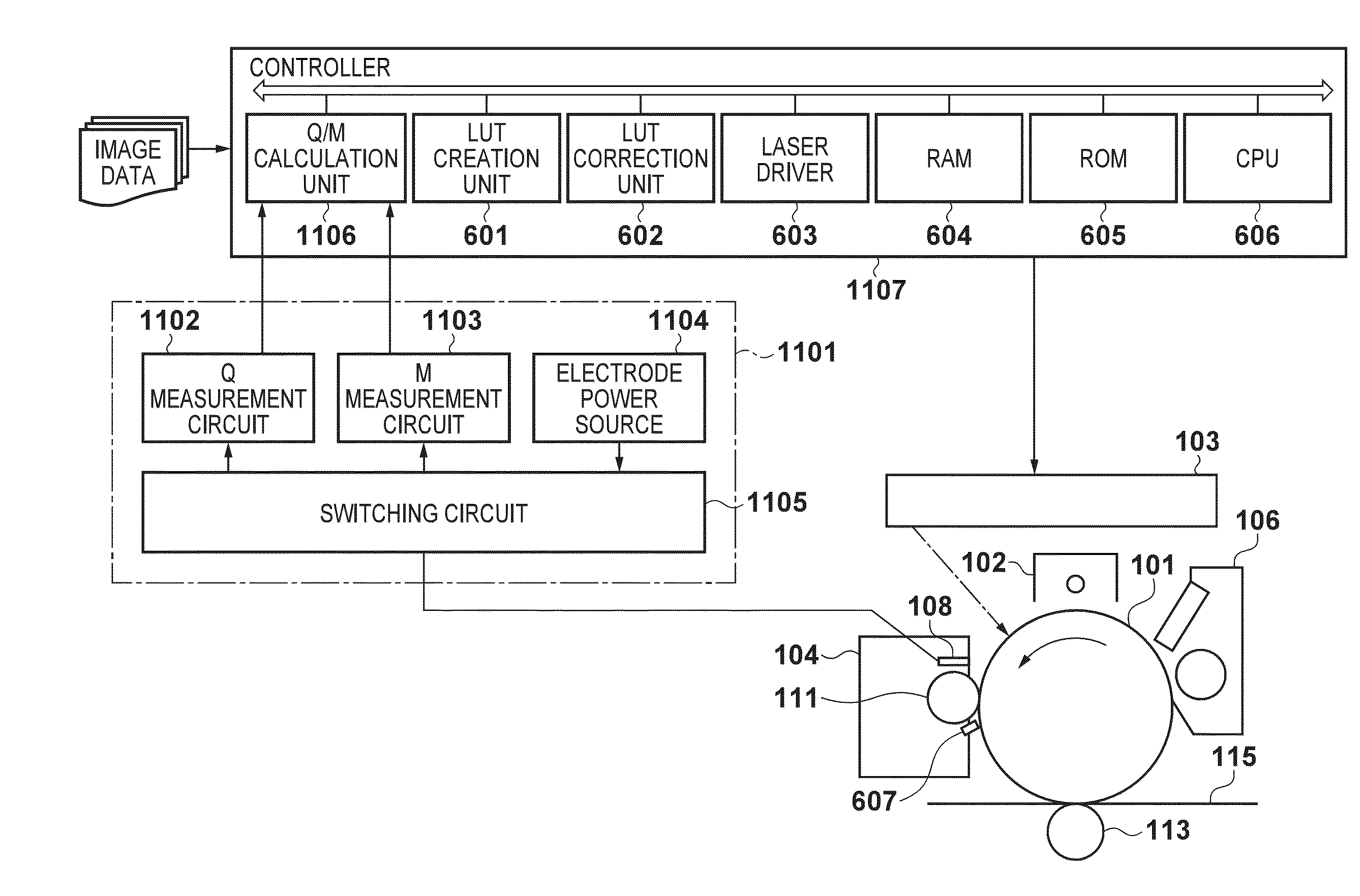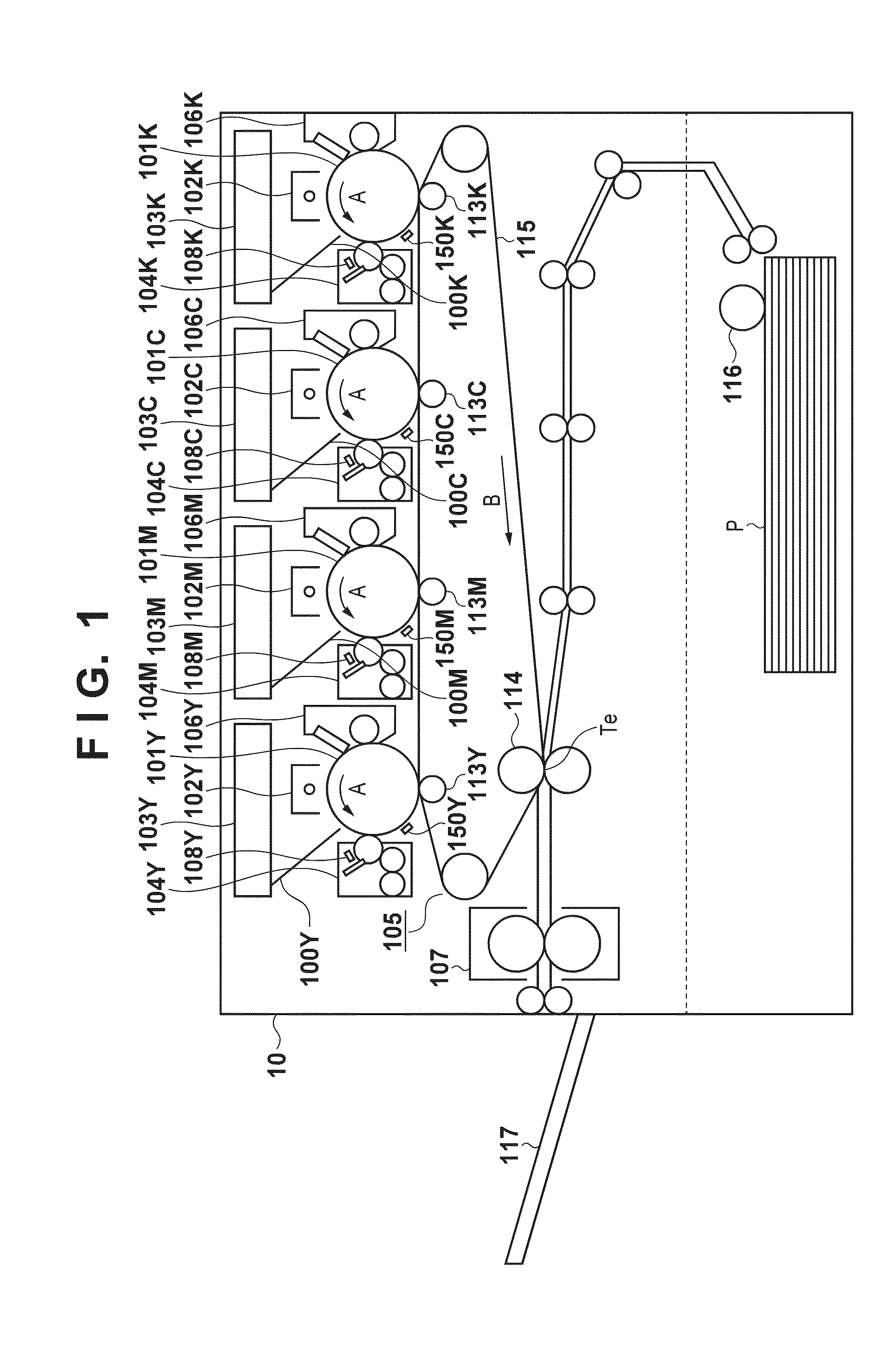Image forming apparatus
a technology of image forming apparatus and forming conditions, which is applied in the direction of electrographic process apparatus, instruments, optics, etc., can solve the problems of inability to set the precise forming conditions of the toner image at the desired density, and the change of the charge amount of the toner in the developer
- Summary
- Abstract
- Description
- Claims
- Application Information
AI Technical Summary
Benefits of technology
Problems solved by technology
Method used
Image
Examples
first embodiment
Apparatus Configuration
[0037]FIG. 1 is a diagram illustrating the overall configuration of an electrophotographic image forming apparatus.
[0038]Charging apparatuses 102Y, 102M, 102C, and 102K, laser scanners 103Y, 103M, 103C, and 103K, developing apparatuses 104Y, 104M, 104C, and 104K, and drum cleaners 106Y, 106M, 106C, and 106K are arranged in the periphery of photosensitive drums 101Y, 101M, 101C, and 101K, respectively. Images of respective color components are formed upon the photosensitive drums 101Y, 101M, 101C, and 101K in an image forming process, which will be described later. Here, a yellow image is formed upon the photosensitive drum 101Y, a magenta image is formed upon the photosensitive drum 101M, a cyan image is formed upon the photosensitive drum 101C, and a black image is formed upon the photosensitive drum 101K. Meanwhile, primary transfer rollers 113Y, 113M, 113C, and 113K transfer the respective color component images onto an intermediate transfer belt 115 so tha...
second embodiment
[0161]According to the first embodiment, real-time control is carried out using a configuration that corresponds to FIG. 12 and Formula (7), but because the measurement position and the exposure position are close to each other, it is possible that the control of the exposing conditions will be too late in the case where even a slight amount of delay, such as signal delay, occurs.
[0162]Accordingly, in the second embodiment, the configuration of the developing apparatus 104 is changed in order to lengthen the time Tqcm from the measurement position to the developing position. FIG. 24 is a schematic diagram illustrating the configuration of the developing apparatus 104 according to the second embodiment. The operations of the image forming apparatus and the operations performed in the toner charge amount measurement sequence are the same as those described in the first embodiment, and thus descriptions thereof will be omitted in the present embodiment. The developing apparatus 104 sho...
third embodiment
[0165]In the first embodiment, the charge amount measurement unit 108 is disposed in a position, facing the developing sleeve 111, in a path along which the toner on the developing sleeve 111 traverses the regulation blade 112 and reaches the developing position.
[0166]However, in the case where the conditions illustrated in FIG. 12 and indicated by Formula (7) are not met, real-time tone control cannot be carried out. For example, apparatuses that increase the rotational velocity of the developing sleeve 111 in order to increase the printing speed, apparatuses in which the diameter of the developing sleeve 111 has been reduced in order to miniaturize the apparatus, and so on may not be able to meet the condition indicated in Formula (7).
[0167]In the third embodiment, the exposing conditions are controlled in accordance with a predicted result of measuring the toner charge amount even in the case where the exposing conditions cannot be controlled in real time.
[0168]FIGS. 13A and 13B ...
PUM
 Login to View More
Login to View More Abstract
Description
Claims
Application Information
 Login to View More
Login to View More - R&D
- Intellectual Property
- Life Sciences
- Materials
- Tech Scout
- Unparalleled Data Quality
- Higher Quality Content
- 60% Fewer Hallucinations
Browse by: Latest US Patents, China's latest patents, Technical Efficacy Thesaurus, Application Domain, Technology Topic, Popular Technical Reports.
© 2025 PatSnap. All rights reserved.Legal|Privacy policy|Modern Slavery Act Transparency Statement|Sitemap|About US| Contact US: help@patsnap.com



